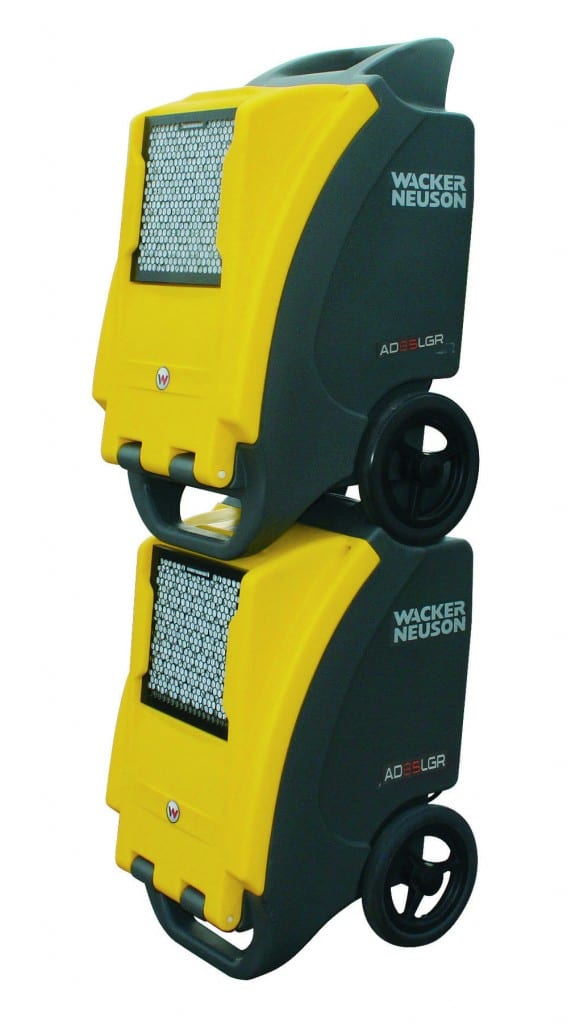Moisture is not the construction contractor’s friend. Framing lumber, plasterboard, and hardwood flooring, in particular, require dry conditions to perform properly. But Mother Nature does not always cooperate. Spring showers and high summer humidity can lead to construction delays and liquidated damages.
Fortunately, the right dehumidifier can bring your jobsite to peak moisture content and ready for finish work in no time. Wacker’s low-grain refrigeration dehumidifiers gradually reduce the relative humidity in buildings under construction by attracting water vapor that is trapped in wood, concrete, drywall, and other building materials. How much and how fast the drying takes place depends on the materials, the ambient temperature and humidity, and how powerful and how many dehumidifiers are used.
Wacker equipment is especially useful in three phases of building construction:
 1. Framing
1. Framing
Wooden framing members shrink and swell as they absorb and relinquish water to and from their fibers. Only when the wood absorbs and holds more than the fibers’ capacity – about 28% saturation – will it begin to deteriorate. Lumber that gets wet – either before or after it is nailed into framing – should be dried as soon as possible, both to stave off rot and to bring the moisture content down to a workable level. Even in the absence of rain, wood will absorb water vapor from the air. Often even this equilibrium moisture content is high enough for mold to flourish.
Generally, dehumidifiers should be used until moisture content readings fall to between 15% and 19%, depending on the climate in your region. Only then is it advisable to proceed with the next phase of construction.
2. Drywall
That next phase, drywall, effectively seals the framing, inhibiting air flow and virtually cutting off the drying process. The wood must be below 19% moisture content to prohibit the growth of mold on the framing and the back of the plasterboard panels. The drywall itself can absorb water vapor, causing cracks and nail popping as the wallboard swells and shrinks. Drywall joint compound, or “mud” is a notoriously slow dryer.
When humidity invades the building under construction, a dehumidifier can make the difference in drying the mud enough to sand. The dehumidifier also will draw moisture from the drywall itself. Only when the content is driven down to less than 1% can paint be expected not to crack.
3. Flooring
Laying vinyl, carpet, and especially hardwood flooring materials on a concrete slab that has not been dried with dehumidifying equipment is asking for trouble. Excess moisture in the slab not only provides an attractive medium for mold, it also causes cupping. As water vapor escapes the concrete it is absorbed into the bottom of the planks, causing the plank edges to lift, creating concavity. Dehumidifiers pull the vapor from the slab before the hardwood and engineered wood flooring is placed atop it.
By extracting the excess moisture content from the concrete slab, contractors also make adhesives more effective in securing carpet vinyl, and rubber floor coverings and eliminate the possibility that moisture will soak emerge from the concrete later and cause staining as carpet or vinyl absorbs it.
Dry Your Site and Speed Construction with Wacker Dehumidifiers
The Pro Group carries Wacker equipment and Wacker dehumidifiers, which pre-cool the ambient air, conditioning it in order to remove significantly more humidity that traditional dehumidifiers. This pre-treatment of the air makes them effective in drying the most stubborn construction materials – even in relatively low-humidity conditions.
Check out our supply and rental line of Wacker equipment or call us at (857) 706-2980 for more information on Wacker dehumidifiers or to discuss how to best remove excess moisture from your construction site.


 1. Framing
1. Framing
